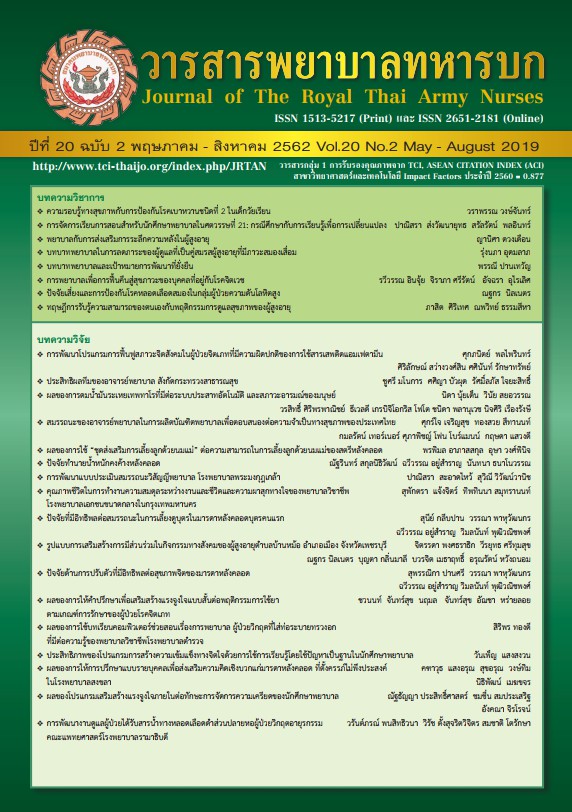Effects of Pulmonary Rehabilitation Program To Prevent Exacerbation in Patient With Chronic Obstructive Pulmonary Disease In Community
Keywords:
Chronic Obstructive Pulmonary Disease, Recurrence of exacerbation, pulmonary rehabilitation programAbstract
This Quasi-experimental research aim to assess the effects of pulmonary rehabilitation program among chronic obstructive pulmonary disease(COPD) patients in community. 30 COPD patients who met the criteria were recruited in the study, The sample were split into 2 groups, 15 of them were experimental group who received pulmonary rehabilitation program the others 15 were comparative group who received normal care. Data gathering tools were personal interview form of COPD and risk factors of exacerbation, health assessment form, and evaluation of dyspnea were include DVAS, FEV1, PEF and blowing-sucking water bottom. The period of the study were 12 weeks. Data were analyzed by mean, standard deviation and use Mann- whitney U test The results revealed that the experimental group had an average of dyspnea score; from evaluation as following ; DVAS = 24 (S.D = 9.10) , FEV1 = 1.72 (S.D = 0.32) , PEF = 3.73 (S.D = 54.05) and blowing-sucking water bottom = 8.78 (S.D = 0.74). The comparative group had an average score of dyspnea from evaluation as following ; DVAS = 26 (S.D = 9.85), FEV1 = 1.69 (S.D = 0.32),PEF = 3.95 (S.D = 42.13) and blowing-sucking water bottom = 7.39 (S.D = 1.17). When compared dyspnea by Mann- whitney U test. Experimental group and comparative group was non-significant difference at .05 when assessment of DVAS, FEV1 and PEF but assessment of blowing-sucking water bottom found comparison group have dyspnea less than experimental group was statistical significant difference at .01 (p-value =.002)
Downloads
References
Office of Policy and Strategy Office of the Permanent Secretary. Summary of important statistics 2013. Nonthaburi: Office of the Permanent Secretary Ministry of Public Health. 2013 (in Thai)
Phothirat C. Respiratory rehabilitation in patients with chronic obstructive pulmonary disease. Tuberculosis Journal. 2007; 25 (3-4), 159-167. (in Thai)
Chakkhon J. Effects of general and applied lung rehabilitation on functional performance of Lung and ability to do activities of chronic obstructive pulmonary disease patients. Nursing Substance. 2009 ; 36 (3), 102-113. (in Thai)
Fortyang S. The results of the program to promote dyspnea management on the quality of life of people with the disease COPD. Phom (Community Practice Nursing) Chiang Mai: Graduate School Chiang Mai University. 2004 (in Thai)
Maykul S. Effects of self-care promotion program on dyspnea of chronic obstructive pulmonary disease patients. Ph.D (Community Practice Nursing) Bangkok: Graduate School Chulalongkorn University. 2005 (in Thai)
Khodrata P. The effect of using self-management program on dyspnea of Monks, chronic obstructive pulmonary disease. Phom (Community Practice Nursing) Bangkok: Graduate School Chulalongkorn University. 2004 (in Thai)
Aranyachai Y, Phatthananatakun P. The effect of using a blown bottle innovation for lung rehabilitation In patients with chronic obstructive pulmonary disease. Chiang Khong Crown Prince Hospital, Chiang Rai. 2010 (in Thai)
Imsuwan J. Synthesis of research on pulmonary rehabilitation program In patients with COPD. Nov. (Community Practice Nurse) Nakhon Pathom: Graduate School Mahidol University. 2010 (in Thai)
Kitchatham W. Analysis of reference statistics. Teaching materials. 2007 (in Thai)
Boonsawat W. Guidelines for care for patients with chronic obstructive pulmonary disease. Teachings. Department of Medicine Faculty of Medicine Khonkaen University. 2005 (in Thai)
Theerabutra A. Chronic Obstructive Pulmonary Disease: Self-Care and Rehabilitation. Khon Kaen : Siriphan Offset.1999 (in Thai)
Treewichar W, Khungtumneam K, Buajalearn H. Guideline for Management the Acute Exacerbation at home by Chronic Obstructive Pulmonary Disease: COPD patient. Journal of The Royal Thai Army Nurses. 2017 ; 18(1), 216-221 (in Thai)
Chompikul R., Jirapaet V. Experience The Difficulty of Caregivers in Caring for Infant with Chronic Lung Disease at Home. Journal of The Royal Thai Army Nurses. 2019;20(1):138-146 (in Thai)
Downloads
Published
How to Cite
Issue
Section
License
บทความหรือข้อคิดเห็นใดใดที่ปรากฏในวารสารพยาบาลทหารบกเป็นวรรณกรรมของผู้เขียน ซึ่งบรรณาธิการหรือสมาคมพยาบาลทหารบก ไม่จำเป็นต้องเห็นด้วย
บทความที่ได้รับการตีพิมพ์เป็นลิขสิทธิ์ของวารสารพยาบาลทหารบก
The ideas and opinions expressed in the Journal of The Royal Thai Army Nurses are those of the authors and not necessarily those
of the editor or Royal Thai Army Nurses Association.






